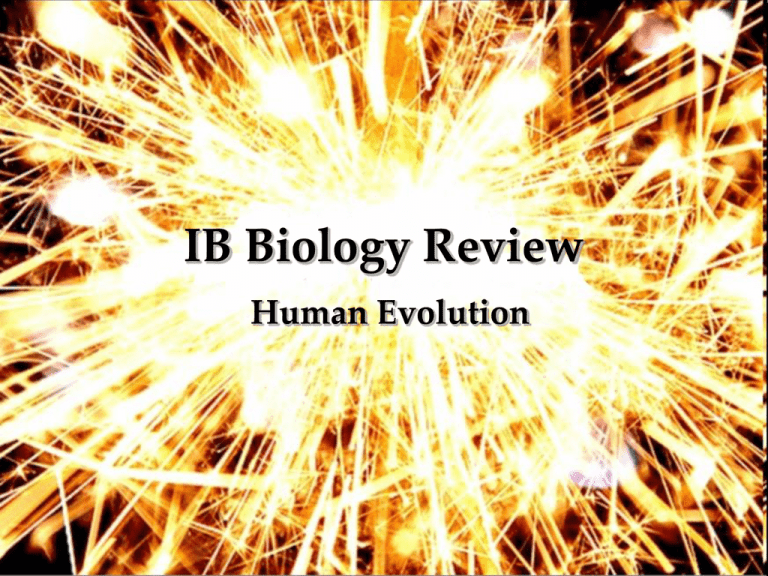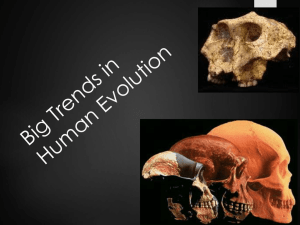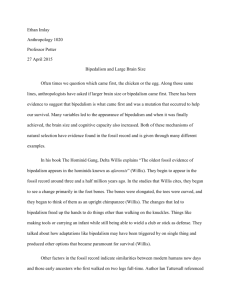Senior IB Bio Review
advertisement

IB Biology Review Human Evolution Taxonomy of Humans Kingdom: Phylum: Class: Order: Family: Genus: Species: Animalia Chordata Mammalia Primate Hominidae Homo Sapiens Chronological Line of Human Evolution Australopithecus afarensis Australopithecus africanus Australopithecus robustus Homo habilis Homo erectus Homo sapiens Which species are alive? Only Homo sapiens Biochemical Evidence for Human Evolution from Apes similar amino acid sequence similar DNA sequences remember, chimpanzees share 98% of their genes with humans Anatomical Evidence for Human Evolution from Apes Both humans and apes have grasping limbs opposable thumb stereoscopic vision retention of juvenile features (hairless at birth) similar cranial features no tail rotatable shoulder joint What four physical traits define humans as primates? Have opposable thumb / power grip Have well developed cerebral cortex / brain Have limber shoulder joints Have finger pads / fingerprints / nails (not claws) When did bipedalism come about? bipedalism evolved in hominids about 5 million years ago fossil footprints found (at Laetoli) 3.6 million years ago anatomy of hominids suggests bipedality at 4.4 million years ago How did bipedalism change the life of early hominids? bipedality provides greater field of view for foraging, detecting predators or traveling bipedality is an efficient way to move bipedality frees hands for manipulation Which anatomical features help humans to be bipedal? arches on feet support weight and absorb shock stronger bones in legs / stronger legs allows for all the weight to be carried by two limbs instead of four longer legs bigger stride, more efficient to walk shorter arms long arms not needed to help individual move non-opposable big toe supports weight distribution in foot Which anatomical features help humans to be bipedal? cont. foramen magnum positioned at back and bottom of skull so head can be held upright and still be balanced knees closer together enabled smooth stride wide pelvis enabled leg bones to fit into to hips to allow bipedalism lumbar spine curved absorbs shock from each step larger muscles on legs powered two limbs to move body instead of four limbs Position of the Foramen Magnum Humans Directly under head Resting above spine Humans stand straight up, don’t need spine to be angled into head Ape Towards back of head Spine slanted into head Apes don’t stand straight up How was Australopithecus afarensis the prototype human? Had non-opposable big toe Had a broad pelvis Had more vertical posture Skull on top of vertebrae Long legs indicating bipedality Curved finger bones meaning it was still living in trees Why did Australopithecus start walking on two legs? Environment changed It used to live in dense forest Drought killed off forest Became savannah Had to leave trees Had to travel far distances to get food and water What is genetic evolution? Evolution through variation and inheritance of genes Changes the physical features of the body What is cultural evolution? Evolution through customs like languages, etc. that are taught/learned Why does cultural evolution depend on increases in brain size? Organisms can’t use a part of the brain that isn’t there! The new parts of the brain (neocortex) deal mostly with language and art Language and art could not be developed before the brain capacity was there IB Exam Question 1. State the order, class, family, genus and species of human beings. (1 mark) Order: Primate Class: Mammalia Family: Hominidae Genus: Homo Species: sapiens IB Exam Question 2. Discuss the anatomical and biochemical evidence which suggests that humans arose from a species of ape. (6 marks) biochemical evidence: similar amino acid sequence (e.g. cytochrome, hemoglobin); similar DNA sequences; anatomical evidence: grasping limbs; opposable thumb; stereoscopic vision; retention of juvenile features (hairless at birth) / neoteny; similar cranial features; no tail; rotatable shoulder joint; IB Exam Question 3. State four major physical features which define humans as primates. (4 marks) opposable thumb / power grip; well developed cerebral cortex / brain; limber shoulder joints; finger pads / fingerprints / nails (not claws); IB Exam Question 4. Discuss the origin and consequences of bipedalism in hominids. (4 marks) Origins: bipedalism evolved in hominids about 5 Mya; fossil footprints found (at Laetoli) 3.6 Mya; anatomy of hominids suggests bipedality at 4.4 Mya; but the fossil record is limited before this date; bipedality possibly associated with a change in habitat / climate / woodland to savannah; Consequences: bipedality provides greater field of view for foraging / detecting predators; bipedality is an economical form of locomotion bipedality frees hands for manipulation / carrying things / gesture; IB Exam Question 5. Discuss the anatomical features that enable bipedalism in humans. (3 marks) arches on feet; stronger bones in legs / stronger legs; longer legs; shorter arms; non-opposable big toe; foramen magnum; knees closer together; wide pelvis; lumbar spine curved; larger muscles on legs; IB Exam Question 6. Outline the trends illustrated by the fossils of Australopithecus afarensis. (3 marks) non opposable big toe / broad pelvis / more vertical posture / skull on top of vertebrae; short legs indicating bipedality; curved finger bones / phalanges; indicating it was still arboreal; dentition more like a chimp / larger canines / parallel molars; IB Exam Question 7. Discuss the possible habitat of Australopithecus and the ecological changes that might have prompted its origin. (3 marks) about five million years ago; it became drier; it became cooler; dense forest was replaced by thin woodland / clearing; evolution of bipedalism (started leaving trees); vegetarians; incompleteness of fossil record causes uncertainties about human evolution; IB Exam Question 8. Outline the difference between genetic and cultural evolution. (2 marks) genetic evolution through variation and reproduction / inheritance of genes; cultural evolution through customs / languages, etc. taught/learned; IB Exam Question 9. Discuss how cultural evolution in humans depended on increases in brain size. (3 marks) large brain size correlates with language; large brain correlates with improvements in tool-making improved tools allow more nutritious diets for further brain development (especially hunting tools); increased brain size leads to written history / cave art / symbolic thought; IB Exam Question 10. Discuss the relative contributions of genetic and cultural evolution in the evolution of humans. (6 marks) In genetic evolution, the unit of genetic inheritance is the gene; genetic evolution leads to changes in anatomy/physiology; such as large brain / bipedality / other example; unit of cultural inheritance is word /gesture /image /symbol /language /tool; culture is largely acquired / Lamarkian; genetic inheritance is Darwinian; cultural evolution linked to technology / cultural revolutions (e.g. agriculture); both genetic and cultural evolution allow humans to rise above environmental limiting factors such as food / water / shelter / disease; cultural evolution more rapid than genetic evolution; genetic evolution still occurring (through changes in allele frequency due to differential reproductive rates of certain races); e.g. sickle cell anaemia and resistance to malaria / HIV resistance / other example; genetic inheritance precedes cultural evolution; brain size increases through genetic evolution enabling cultural evolution; IB Exam Question 11. Explain why the approximate date and distribution of H. habilis are uncertain. (3 marks) 2 (±0.5) million years ago in (sub-Saharan) Africa; uncertain because fossils lacking or not in good form; soft parts do not fossilize; interbreeding of species;










